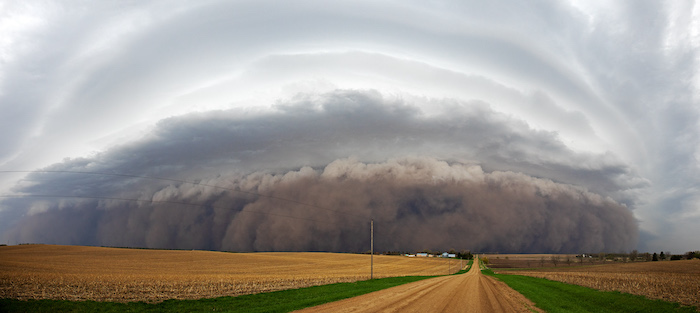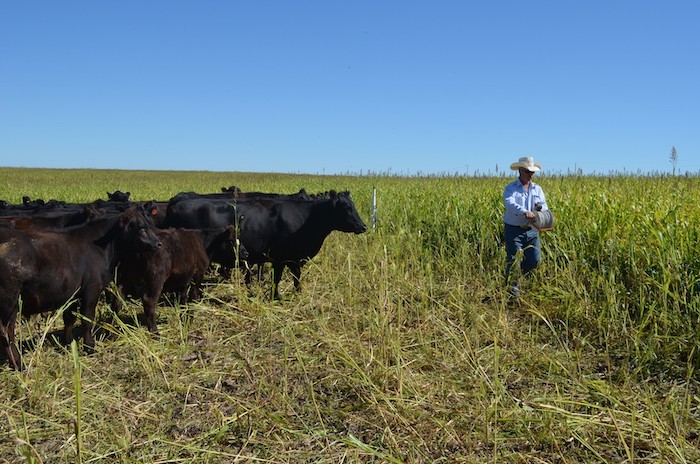By Julia Gerlach, Soil Health Specialist, Conservation Technology Information Center
Dirt cheap. Treat like dirt. Drag through the dirt.We’ve all heard – and probably used – these and other negative idioms. They are, after all, old as dirt. Sorry, it couldn’t be helped. But truly, it’s no way to talk about agriculture’s most precious commodity – the soil.Dust in the wind
It’s easy to think of the soil as an infinite resource, that it will always be there. But the fact is many prior civilizations have met their peril as a result of destroying their soils. David Montgomery wrote about this in Dirt: The Erosion of Civilizations, as did Walter Lowdermilk in his 1953 booklet Conquest of the Land Through 7,000 Years. Both books trace the destruction and erosion of soil that has gone hand-in-hand with the fall of civilizations throughout the ages.In the Dakota Lakes Research Farm (DLRF) Annual Progress Report 2022, former DLRF manager and no-till pioneer Dwayne Beck reminds readers that the westward expansion of the United States that occurred with the Louisiana Purchase was in many ways a result of soil degradation that began with the birth of agriculture.“When hunter-gatherer societies were replaced with agriculture, there was also a switch from using contemporary nutrients to grow plants to a system that was based on accelerating the natural release of nutrients from the soil through the use of tillage and/or fire,” he writes. “Even in the early phases this led to widespread degradation of soils and ecosystems.”He goes on to explain that the colonization of Africa, Australia and the western hemisphere was “an effort to find land that had not been degraded to support population growth.”The degradation of the soil continued to follow each new society as settlers brought to the new lands the very cultivation methods that had created the erosion problems they were seeking to escape.Beck goes on to explain that founding fathers George Washington, Alexander Hamilton and Thomas Jefferson expressed concern about soil degradation on the eastern seaboard in their correspondence in the 1790s.“They felt better husbandry was required to prevent further damage,” Beck writes. “If improvement was not made, then it would be necessary to look westward for new lands. The Louisiana Purchase occurred seven years later. In just over one hundred years, the Dust Bowl impacted the newly purchased land because techniques had not changed.”While the dust storms of the Dirty Thirties may seem like a thing of the past, intense storms in the last year or so have kicked up walls of dirt that traveled hundreds of miles, depositing South Dakota soil far and wide. On May 13, 2022, social media was full of images of a massive dust storm as it passed through the eastern part of South Dakota and into Minnesota. That storm caused two deaths and millions of dollars in damage. On May 1, 2023, a massive accident due to a dust storm in Illinois involving 30 commercial trucks and more than 50 passenger vehicles resulted in 7 deaths and 30 hospitalizations.

A windstorm kicked up a massive cloud of soil and dust that traveled through the eastern part of South Dakota and into Minnesota in May 2022. Experts estimate the storm stripped away 1-2 mm of soil from farms across the state. Photo by Christian Begeman.
Cover Up
It's convenient to think of recent windstorms as freak events and to imagine that aggregated soil loss is not that severe. But a 2022 study that appeared in the journal AGU Advances found historical soil erosion rates averaging nearly 2 mm per year, which is almost double the rate considered “tolerable” by the United States Department of Agriculture (USDA).If a 2 mm loss equates to 12 tons per acre, and South Dakota has 41 million acres of farmland, that’s a LOT of topsoil being whisked away every year. And besides the physical soil loss, this erosion also represents a loss of applied nutrients, reduced soil organic matter and a loss of soil moisture, all of which costs farmers money.The good news is that management practices can help stave off erosion and protect the soil during big wind and rain events. Planting cover crops after harvest, for instance, helps keep soil in place, adds organic matter and improves water-holding capacity in the soil.According to Operational Tillage Information System (OpTIS) data, only about 3% of farmland acres in South Dakota were planted with cover crops in 2021, the most recent year for which data is available. This lags behind the average 5.9% of acres planted with covers nationwide that year.While the benefits of using cover crops are well established and widely understood, implementation remains challenging in the state where the growing season averages just 135 days between the last and first frost, and precipitation swings wildly from too much to not enough.Furthermore, many farmers are reluctant to plant cover crops because of a perception that they are a financial risk, either in terms of negatively impacting yield on the following cash crop or from the expense of the seed itself and related management – or both.Results from a recent study by the Soil Health Institute (SHI), however, suggest that adopting cover crops and other soil health practices can help farmers improve profitability in the long run.In a press release about the study, Dr. Wayne Honeycutt, President and CEO of SHI, said, “We know practices like cover crops and no-till benefit the environment by storing soil carbon, reducing greenhouse gas emissions and improving water quality. However, investing in soil health is also a business decision. This project provides farmers with the economic information they need to feel confident when making that decision.”The study included in-depth interviews with 30 farmers across 20 states with an established history of successful implementation of a wide range of soil health management systems including cover crops, no-till, planting green, rotational grazing and more. SHI designed the interviews to “learn about farmers’ experiences with adopting those systems and to evaluate their economics by comparing the costs and benefits before and after practice adoption,” the press release stated.The study found that 29 of the 30 farms increased net farm income by an average of $65 per acre through a combination of reduced costs and increased yields in the cash crop parts of the rotation. Farmers also reported decreased soil erosion and compaction, earlier access to fields in wet years and increased resilience to extreme weather.Doug Sieck, a no-tiller from Selby, S.D., who started adding cover crops to his corn-soybean-wheat rotation in fall 2006, can relate. While today he is a vocal advocate for cover crops and caring for the soil, he says his interest in soil health didn’t begin altruistically.“My original motivation really wasn’t the health of the soil,” he says. “It was financial.”Sieck says he was inspired by Bismarck-area no-tiller Gabe Brown, whose farm was part of a South Dakota Crop Improvement bus tour that year. While standing in a chest-high warm-season cover crop, Brown explained that the cover crops were boosting his profits by allowing him to cut back on the use of fertilizers and pesticides. Intrigued, Sieck decided to seed about 30 acres to a mix of winter triticale and hairy vetch after soybean harvest.“I also threw in some turnips or radishes just for fun,” he says. “I planted it to cut for hay the next year, and it worked out really well. I got a lot of bulk off of it.”Sieck, who considers himself a cattleman first and a farmer second, could see the potential for using cover crops to feed his livestock while also benefiting the soil.

Doug Sieck of Selby, S.D., sets out temporary polywire fencing to manage which cover crop fields his cows have access to. Photo courtesy of Doug Sieck.
Show Me the Money
But Sieck says if he hadn’t been able to see a way to make it profitable, he may never have tried cover crops.“Whether it’s cover crops or no-till methods, I don’t think many of us are such great conservationists that we adopt or try those practices just for altruistic benefit. To get people to try these things, there has to be a financial incentive.”Sieck recalls when one of his neighbors started using a John Deere 750 no-till drill.“He told people he got a 3-5 bushel increase due to using that drill,” Sieck says. “I’m pretty sure farmers around here started no-tilling for the financial advantage, and I think getting people to adopt cover crops is very similar.”As for himself, though he says he’s made “loads of mistakes,” he’s committed to keeping cover crops in his rotation, and he’s now doing it without the help of incentive programs.For those who are new to covers, help is at hand as new, innovative programs from the USDA’s Climate Smart Commodities Partnership initiative are being rolled out to assist farmers in making the transition.Farmers for Soil Health, a collaborative effort initiated by the National Corn Growers Association, United Soybean Board and the National Pork Board, is a farmer-driven sustainability program designed to enhance soil health and promote the adoption of cover crops. With a vision of expanding cover crops to 30 million acres by 2030, Farmers for Soil Health is a 20-state initiative covering the region from North Dakota to Kansas at the western edge, all the way to the east coast.In South Dakota, Farmers for Soil Health is being implemented by the Conservation Technology Information Center (CTIC), a non-profit that has been working with farmers on conservation efforts for 41 years. CTIC is also implementing the program in Minnesota and Wisconsin.CTIC’s goal is to enroll 500 farmers, representing 87,000 acres across the three states, into the Farmers for Soil Health program. Farmers for Soil Health allows producers to easily self-enroll if they choose, streamlining the enrollment process for quick and straightforward access. The 3-year program offers a decreasing schedule of incentive payments on acres that have not been previously planted to cover crops: $25 for the first year, $15 for the second year, and $10 for the third year.Farmers for Soil Health stands out for its commitment to simplifying sustainable farming while offering flexibility and local support. The program was designed by farmers for farmers, offering straightforward participation with no need for income verification, making it accessible to a wide range of farmers.In addition, Farmers for Soil Health opens the door to the DTN Sustainability Marketplace, a valuable resource that goes beyond just financial incentives, providing opportunities for farmers to connect with conservation-minded buyers and receive premiums for crops grown with regenerative agriculture at its center.Flexibility is a cornerstone of Farmers for Soil Health. Farmers have the freedom to select cover crop species that align with their unique needs and local conditions, offering a tailored approach to sustainable agriculture.Local technical assistance is another key advantage of the program. This on-the-ground support ensures that farmers can effectively implement sustainable practices and maximize their benefits without facing unnecessary hurdles. Furthermore, the program minimizes the administrative burden with simplified documentation requirements, allowing producers to focus on what matters most: improving soil health and promoting sustainability in their farming operations.Besides providing assistance with enrollment in the Farmers for Soil Health program, CTIC’s state-based soil health specialists and cover crop coaches are available to work with farmers on identifying ecosystem resource concerns, selecting appropriate cover crops, providing seeding rate recommendations, finding cover crop seed providers, consulting on establishment and termination techniques and more.Farmers for Soil Health is more than just a financial incentive program; it is a comprehensive approach to sustainable farming that offers accessibility, flexibility, local support and an ecosystem of opportunities, all while acknowledging the unique needs of each participating farmer.It’s imperative that soil be protected and conserved as much as possible because the simple fact is that we no longer have the luxury of leaving our degraded soils in the dust as we go in search of new ground. We must take care of the soil if we have any hope that it will continue to provide for us. With the help of programs like Farmers for Soil Health, in a few short years, hopefully less of our soil will be degraded and treated like dirt. Learn more at www.farmersforsoilhealth.com.
Related Content
Study: Ag Practices Have Caused 57.6 Trillion Metric Tons of Soil Loss in Midwest
CTIC Partners with Farmers for Soil Health to Increase Cover Crop Acres
Planting Green Cover Crops into Cash Crops Can Be Successful






